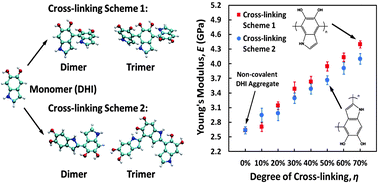Tuning heterogeneous poly(dopamine) structures and mechanics: in silico covalent cross-linking and thin film nanoindentation†
Abstract
Mussel-inspired synthetic poly(dopamine) thin films from dihydroxyphenylalanine (DOPA) and lysine, structurally similar to natural melanin, have drawn extensive interest as a versatile surface functionalization and coating material for use in a broad range of applications. In order to gain a better understanding of its complex and heterogeneous polymeric structure and mechanical properties, we report a computational model of poly(dopamine) by mimicking the polymerization process of the intermediate oxidized product of dopamine, 5,6-dihydroxyindole (DHI), via controlled in silico covalent cross-linking under the two most possible reaction schemes proposed in experiments. To validate our results using experiment, we synthesize poly(dopamine) thin films and perform experimental nanoindentations on the film. We observe an overall linear behavior for Young's modulus as a function of the degree of cross-linking, demonstrating the possibility of enhancing the mechanical robustness of poly(dopamine) materials by increasing the extent of polymerization. At the highest degree of polymerization considered (70%), the model mimics the linear tetrameric model for poly(dopamine) and melanin. At this degree of polymerization, we find a Young's modulus of 4.1–4.4 GPa, in agreement with our nanoindentation results of 4.3–10.5 GPa, previous experiments for natural melanin, as well as simulation results for the cyclic tetrameric melanin model (Chen et al., ACS Nano, 2013). Our results suggest that the non-covalent DHI aggregate model might not be appropriate to represent the structure of poly(dopamine) and melanin-like materials, since it gives a much smaller Young's modulus than the experimental lower bound. Our model not only nicely complements the previous computational work, but also provides new computational tools to study the heterogeneous structural and physicochemical properties of poly(dopamine) and melanin, as well as their formation pathways.


 Please wait while we load your content...
Please wait while we load your content...